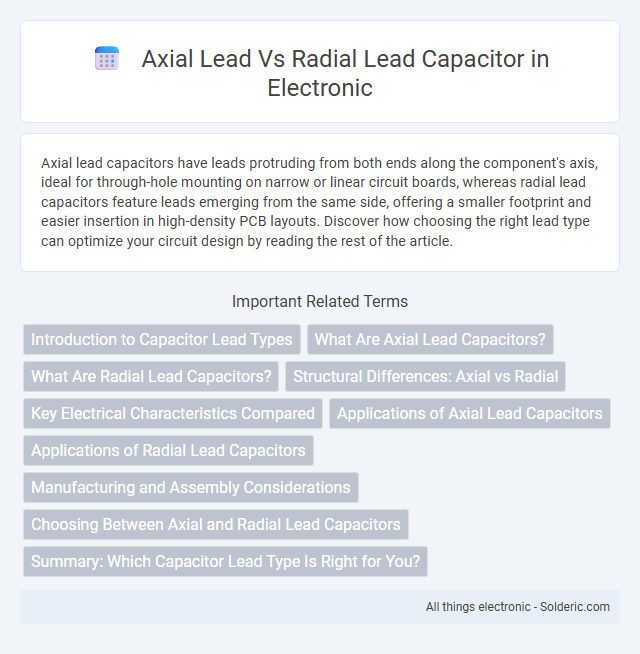Axial lead capacitors have leads protruding from both ends along the component's axis, ideal for through-hole mounting on narrow or linear circuit boards, whereas radial lead capacitors feature leads emerging from the same side, offering a smaller footprint and easier insertion in high-density PCB layouts. Discover how choosing the right lead type can optimize your circuit design by reading the rest of the article.
Comparison Table
| Feature | Axial Lead Capacitor | Radial Lead Capacacitor |
|---|---|---|
| Lead Orientation | Leads extend from opposite ends along the axis | Leads extend from the same side, perpendicular to the board |
| Mounting Style | Horizontal mount on PCB | Vertical mount on PCB |
| Size & Shape | Longer, cylindrical shape | Compact, shorter height |
| Common Uses | High voltage, through-hole applications | Space-saving in compact circuits |
| Mechanical Stability | Lower mechanical stress on leads | Higher mechanical stress, needs secure mounting |
| Cost | Generally higher due to size | Usually lower, mass produced |
| Examples | Electrolytic capacitors used in power supply filters | Film capacitors in audio and signal applications |
Introduction to Capacitor Lead Types
Axial lead capacitors have leads extending from each end of the cylindrical body, making them ideal for applications requiring a straight-line installation and easy insertion into through-hole PCBs. Radial lead capacitors feature both leads protruding from the same side of the component, allowing for a more compact layout and space-saving design on the circuit board. Understanding the differences in lead orientation between axial and radial capacitors helps you select the right component for your circuit's layout and assembly needs.
What Are Axial Lead Capacitors?
Axial lead capacitors feature leads extending from both ends of a cylindrical body, allowing for easy insertion in through-hole circuit boards where space is linear. These capacitors are commonly used in applications requiring a low-profile design with leads aligned along the component's axis, making them ideal for compact, high-density circuit layouts. Understanding the characteristics of axial lead capacitors can help you select the best components for efficient circuit board assembly and reliable electronic performance.
What Are Radial Lead Capacitors?
Radial lead capacitors feature two leads extending from the same side of the component, making them ideal for compact circuit board layouts and automated assembly processes. These capacitors are commonly used in electronic devices where space efficiency and ease of mounting are critical, such as in power supplies and consumer electronics. Understanding the design and application of radial lead capacitors helps you choose the best option for your electronic projects requiring reliable and stable capacitance.
Structural Differences: Axial vs Radial
Axial lead capacitors have leads extending from both ends of a cylindrical body, allowing for mounting parallel to the circuit board, which suits narrow spaces. Radial lead capacitors feature both leads protruding from the same side, enabling vertical mounting that conserves horizontal board space. Understanding these structural differences helps you choose the right capacitor configuration for your circuit design's spatial requirements and assembly process.
Key Electrical Characteristics Compared
Axial lead capacitors offer lower equivalent series resistance (ESR) and inductance, making them ideal for high-frequency applications, while radial lead capacitors provide higher capacitance values and greater volumetric efficiency. Radial capacitors typically exhibit higher ripple current ratings due to their larger surface area, enhancing thermal dissipation. Both types differ in dielectric materials and voltage ratings, influencing their stability and performance across temperature ranges.
Applications of Axial Lead Capacitors
Axial lead capacitors are commonly used in applications requiring compact, low-profile components such as in signal coupling, filtering, and timing circuits on printed circuit boards (PCBs). Their lead orientation makes them ideal for through-hole mounting in tight spaces and allows easy insertion into narrow or confined areas within electronic devices. These capacitors are favored in audio equipment, power supplies, and automotive electronics where stability and reliability are critical.
Applications of Radial Lead Capacitors
Radial lead capacitors are commonly used in circuit boards where space efficiency and ease of automated assembly are crucial, such as in consumer electronics, power supplies, and automotive applications. Their compact design makes them ideal for densely packed PCBs, providing reliable filtering, decoupling, and energy storage. You will often find radial lead capacitors in audio equipment, LED drivers, and telecommunications devices, where consistent performance and durability are required.
Manufacturing and Assembly Considerations
Axial lead capacitors feature leads extending from both ends of a cylindrical body, enabling straightforward insertion in through-hole printed circuit boards (PCBs) and making them ideal for automated assembly lines with limited space. Radial lead capacitors, with both leads protruding from the same side, simplify mounting in high-density PCBs and reduce assembly time due to easier orientation and placement. Your manufacturing process benefits from choosing the appropriate capacitor type by balancing board layout constraints, automated insertion capabilities, and assembly line efficiency.
Choosing Between Axial and Radial Lead Capacitors
Choosing between axial and radial lead capacitors depends on your PCB layout and space constraints. Axial lead capacitors have leads on opposite ends, making them ideal for through-hole mounting in narrow spaces or inline circuit paths. Radial lead capacitors feature both leads on one side, allowing for a lower profile and more compact placement on PCBs with limited height clearance.
Summary: Which Capacitor Lead Type Is Right for You?
Axial lead capacitors feature leads extending from both ends along the component's axis, making them ideal for through-hole mounting in tight spaces or applications requiring long lead lengths. Radial lead capacitors have both leads protruding from one side, offering a more compact design suitable for high-density circuit boards and automated assembly processes. Your choice depends on the available space, mounting method, and desired circuit layout efficiency.
Axial lead vs radial lead capacitor Infographic

 solderic.com
solderic.com